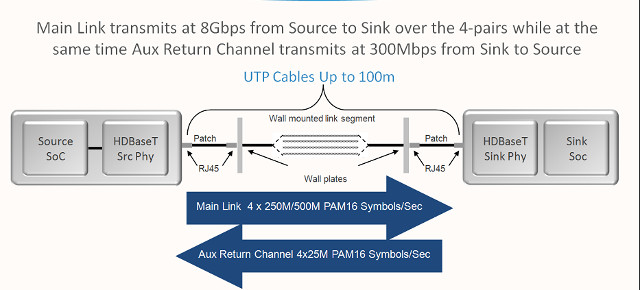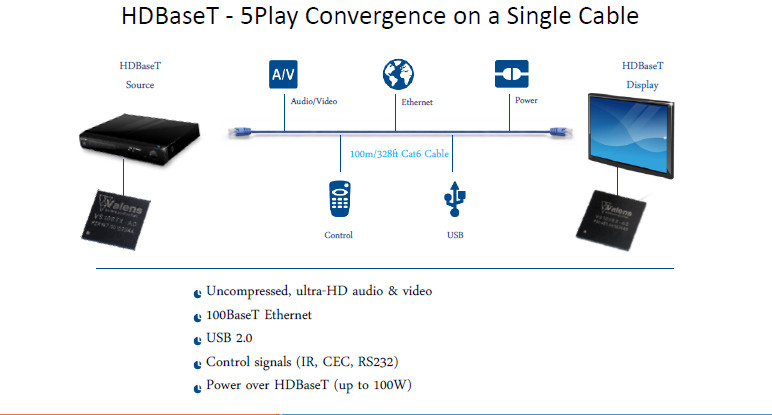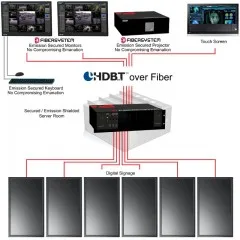HDBaseT is the multi-company alliance organized to develop, promote and certify HDBaseT products and technology based on chip set technology from Valens Semiconductor. At Infocomm 2015, we met with the company and came away impressed with the efforts it is undertaking and the success it is having in moving this technology into mainstream usage.
HDBaseT is an IP-based distribution solution that can deliver power, video, audio, control, USB and Ethernet signals over a CAT or fiber cabling. The length depends upon the features used and the resolution and frame rate of the signal. In a Display Summit presentation (HDBaseT Needs Better Cables for UltraHD (DS14)) delivered by Marketing Chair, Micha Risling, he explained that HDBaseT uses a pulse width amplitude modulation scheme over the 4 twisted pair wires of an Ethernet cable. They use 16 discrete differential voltage levels, each representing 4 bits of data. This results in a data rate of 16 Gbps from source to sink, plus a 300 Mbps auxiliary return channel.

At Infocomm, the HDBaseT Alliance showcased on its booth a number of applications including the first demo of a fiber optic-based solution. This was from a company called Fibersystem. The 45-600 HDMI HDBaseT KVMX extender can now transport keyboard, 4k video, audio, USB and mouse signals up to 300 meters with multi-mode fiber and up to 80km with single mode fiber. No power can be sent over a fiber, of course, but it is much more secure and not prone to electrical interference. The diagram shows the possibilities for a digital signage application.

Other demos featured in the Alliance booth included:
- HDBaseT multimedia home and switch and the single-wire TV
- HDBaseT Audio Return Channel (ARC), AVR and 4k
- HDBaseT fiber solution for medical and security applications
- HDBaseT PCIe card
- HDBaseT digital signage displays
So far, most HDBaseT products are used to extend HDMI signaling, but USB extension products are also coming soon, we were told. Oppo even has a Blu-ray player with HDBaseT output for signal extension.
Higher data rates are coming, as well, in the US3000 Gen 3 chip set that will reach up to 16 Gbps. In the meantime, some companies are also working on bonding two HDBaseT cables to get to 16 Gbps sooner.
The Alliance is now up to 130 members and growing and has launched a compliance testing program to ensure the implementation meets its standards. A web page and mobile app are now also available that lists all of the compliant products so integrators can use this list when configuring solutions to know the system will properly deliver signal from source to sink.
In addition, the Alliance has developed its installer zone that profiles how to use HDBaseT in numerous applications. This will soon be implemented as a searchable database for on-line access.
Analyst Comment
Add it all up and you can see the HDMI Alliance is doing all the right things to foster adoption with a minimum of problems. (CC)

